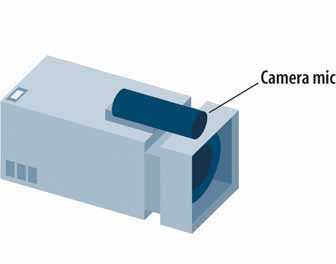Current Recording Options
Depending on what you’re shooting, and depending on your working style as a filmmaker, you have a variety of recording options available. The remainder of this chapter explores a number of different routes you can take, and reasons why you might want to choose one over another. Chapter 8 provides further technical details, and describes how you can put the equipment to use and get the best recording possible.
Using a camera’s onboard mic
Just about all digital video cameras ship with an onboard microphone, usually mounted at the front of the camera above the lens (Figure 7-2). These mics often record stereo audio, and they don’t require any special setup—as soon as you start recording video, the camera mic records audio onto your tape unless you specify otherwise.

Figure 7-2. An onboard microphone.
Pros
Recording sound with the onboard mic is probably the easiest way to capture audio. If you’re in a hectic situation, or working by yourself, this is a no fuss, no muss method that generally provides good results.
Using the onboard mic draws less attention to you during filmmaking than some of the more elaborate audio setups described later. You may want to blend into a crowd (for example, if you’re shooting on location and don’t have a permit, or if you’re making a fly-on-the-wall type documentary), and if you’re working by yourself with just a small camcorder, ...
Get DV Filmmaking now with the O’Reilly learning platform.
O’Reilly members experience books, live events, courses curated by job role, and more from O’Reilly and nearly 200 top publishers.

